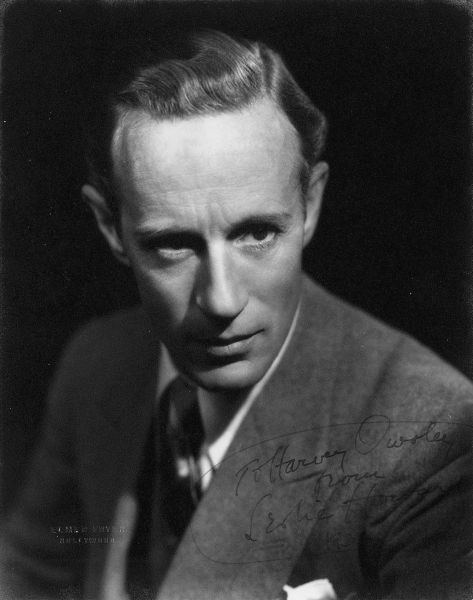| Title: | Flight 777 |
| Subtitle: | The mystery of Leslie Howard |
| Author: | Ian Golvin |
| Editor: | Pen & Sword Books Ltd |
| Published: | January 2013, originally published in 1957 |
| Pages: | 233 |
| Language: | English |
| ISBN: | 9781781590164 |
| Review: |
On June 1st, 1943, Flight 777, a Douglas DC-3, Dakota, was downed over the Gulf of Biscay by German fighter bomber planes when she was on her way from Lisbon to Great Britain. Hereby all occupants lost their lives, amongst whom the well-known British actor Leslie Howard who had returned from Hollywood to the United Kingdom in order to support the British war effort. He did this mainly by being engaged in anti-nazi propaganda. Howard, known from his parts in movies like “The scarlet Pimpernel ” from 1934 and “Gone with the wind” from 1939, had been travelling to Lisbon in order to promote his last movie picture. Onboard also were Howard’s financial council, Alfred Chenhalls, who smoked large cigars and who strongly resembled Winston Churchill. Did the Germans believe that Churchill was onboard Flight 777? Other aircraft taking the same route were left alone by the Luftwaffe in spite of the presence of German fighters over the Gulf of Biscay. These flights were carried out by Dakotas of KLM, chartered by BOAC and operated by Dutch crews. The crew that perished on that first day of June in 1943 was very experienced and had flown that route across the Bay of Biscay many times. “Flight 777 The mystery of Leslie Howard” totally concerns the investigation carried out by journalist and author Ian Colvin towards the end of the 1940s / early fifties, of the cause of the shooting down of the Dutch Dakota. In 1957 he presented the results of his research in a book. Colvin conducted his searching in Great Britain, Portugal, Spain and Germany and interviewed dozens of people amongst whom several former pilots and crewmembers of the Luftwaffe. Ian Colvin was a famous British journalist, who had been employed in Berlin before the war, where he had many secret contacts among the opposition of the Nazis. Hitlers’ regime expelled the journalist from Germany, but early in the 1950s Colvin was able, because of these pre-war contacts, to research the possible reason for shooting down Flight 777. The Douglas DC-3, carrying out Flight 777, was a Dutch aircraft from KLM with the name Ibis. The KLM in those days always baptized her fleet with bird names. The Ibis, with registration PH-ALI, had been delivered to KLM in September 1936 and operated mainly on the route Amsterdam – Batavia. On May 9th, 1940 the aircraft had carried out her scheduled service Amsterdam – Shoreham and was supposed to return the next day to Amsterdam. Because of the German attack on the Netherlands however the crew was ordered to stay in England. On 25 July 1940 the registration of the Ibis was changed into G-AGBB and received a camouflage livery. Together with three other DC-3s of the KLM the Dakota was leased by the British Overseas Airways Corporation (BOAC) and operated on the Bristol – Lisbon route. The experienced crew which lost their lives on 1 June, 1943, consisted of captain Quirinus Tepas, co-pilot Dirk de Koning, flight engineer Engbertus Rosevink and radio operator Cornelis van Brugge. Among the thirteen passengers of Flight 777, next to Leslie Howard and his financial consultant, also six more men, three women and two children were onboard. One of the other male passengers was Wilfred Israel, a Jewish diplomat with a German and a British passport, who had Jewish children smuggled across the French – Spanish border in order to have them sent to Palestine. Herewith Israel was the third person to be a possible target of the Germans, after Howard whom the Germans suspected of being a spy and Alfred Chenhalls looking much alike Churchill. “Flight 777” consists of 22 chapters and in the first 18 Ian Colvin provides a comprehensive introduction and he tries to explain the downing of the Dutch Dakota. Herewith especially those possibilities are highlighted which have a reference to a number of the passengers, possibly targeted by the Germans. The author tries to push the motive for the shooting down of the KLM aircraft over to Leslie Howard, but in the later chapters this appears not be so. By interviewing a number of ex crew members of the Luftwaffe Colvin finds out how the aircraft has been shot down, but it remains guessing, also for him, why the Dakota was pursued by eight Junkers 88-C6s and finally shot down by one of them. Ian Colvin presents a strong suspicion, but for most of the readers that will be a disappointing conclusion. In spite of the fact that the book nowhere becomes thrilling and contains a somewhat disappointing conclusion, it does not strike one as being waggish anywhere. The fact that this concerns a reissue of a 1957 book, could have created a different expectation. The book has been republished rather because this year it is 70 years ago that the facts took place and not because it has been a best seller. But just because the book was written so short after the Second World War, it comes across as very authentic. Because the author himself has experienced the war being a journalist and his deep digging search started right after that worldwide conflict, his story comes across reliable and believable. Apart from that, the writing is smooth and is also good to follow by those readers that don’t read English books so very often. |
| Review: | |
Information
- Translated by:
- Fred Bolle
- Article by:
- Peter Kimenai
- Published on:
- 16-02-2013
- Feedback?
- Send it!






